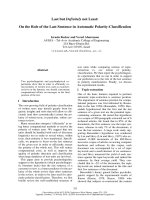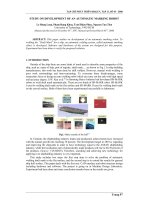Project Report Topic Automatic Outdoor Umbrella.pdf
Bạn đang xem bản rút gọn của tài liệu. Xem và tải ngay bản đầy đủ của tài liệu tại đây (4.01 MB, 17 trang )
<span class="text_page_counter">Trang 1</span><div class="page_container" data-page="1">
<b>HANOI UNIVERSITY OF SCIENCE AND TECHNOLOGY</b>
---úûúû---
<b>ELECTRONICS 1</b>
<b>PROJECT REPORT TOPIC: </b>
<b>Instructor: Dr. Nguyen Canh Quang Group 8 Class: CTTT Co dien tu 01 </b>–
</div><span class="text_page_counter">Trang 2</span><div class="page_container" data-page="2"><b>III.Simulator circuit:</b>
... 12<b>IV. Physical Circuit</b>
... 14<b>V. Conclusion</b>
... 15 </div><span class="text_page_counter">Trang 3</span><div class="page_container" data-page="3"><b> I. Introduction: </b>
<b>1. General information: a. Objective: </b>
Our goal is to create an automatic outdoor umbrella. Using analog circuit knowledge obtained through this electronic course, we will design a circuit can detect humans, rain water, UV rays and control the motor to open and close an umbrella.
<b>b. Block diagram and Operation of Circuit: </b>
</div><span class="text_page_counter">Trang 4</span><div class="page_container" data-page="4">3
<b>1. IR Sensor Circuit a. IR sensor: </b>
IR LED: An infrared light-emitting diode (IR LED) is a solid-state light-e mitting (SSL) device that produces light in the infrared band or range of the electromagnetic radiation spectrum. IR LEDs allow for cost-effective and efficient production of infrared light, which is elec tromagnetic radiation in the 700 nm to 1mm range.
Choosing a resistor connected to IR LED in series: 1.2V; I 20 ; Vcc=+5V
5 1.219020 10
Vcc VR
Select: R ý<sub>1</sub> 220 to ensure that I<sub>LED</sub> is satisfied and protect the LED.
IR Photodiode: An IR photodiode is an electrical component that converts light into electricity. The IR photodiode is used to detect the light rays
reflected by an IR LED.
The IR photodiode is installed as a reverse bias (its cathode is connected to +Vcc). If the photodiode is not exposed to light, the resistance across it will be high, leading to I ý . When the <sub>D</sub> 0photodiode is exposed to light, the electrical resistance across the diode decreases, in creasing the reverse current.
<b>b. Potentiometer: </b>
Potentiometer is an instrument for measuring an electromotive force by balancing it against the potential difference produced by passing a known current through a known variable resistance. Otherwise, it is also a variable resistor with a third adjustable terminal. The potential at the third terminal can be adjusted to give any fraction of the potential across the ends of the resistor.
Select the Potentiometer 10k connected to inverting input of Op-Amp in order to change value of the potential and adjust the sensitivity of the Op-Amp.
<b>c. Operational Amplifier: LM358 </b>
The LM358 is a low-power dual operational amplifier integrated circuit. It can handle +3 V to +32 V DC supply and source up to 20 mA per channel. In this part, it is used as a comparator.
Circuit diagram:
Pin 1: Output voltage, channel 1 (C1)
</div><span class="text_page_counter">Trang 5</span><div class="page_container" data-page="5">Pin 3: Non-inverting input, C1 Pin 4: Ground
Pin 5: Non-inverting input, channel 2 (C2) Pin 6: Inverting input, C2
Pin 7: Output voltage, C2 Pin 8: +Vcc
RI
</div><span class="text_page_counter">Trang 6</span><div class="page_container" data-page="6">5 reverse current I through the resistor <sub>D</sub> R . Following that, the voltage of non-inverting input,<small>2</small> V is equal to that of R , <sub>2</sub> V . <small>R2</small>
Comparation:
øù øùøù øù
Actually, because of temperature, load and type of Op-amp, V<sub>out</sub><small>1</small>ýVcc 1;1.5.
<b> In our condition, </b>V<sub>out</sub><sub>1</sub> ýVcc 1.2ý3.8V In the end of this stage, we get V<sub>out</sub><sub>1</sub>.
<b>2. UV Sensor Circuit </b>
<b>a. UV sensor module: GUVA-S12SD </b>
UV sensors measure the power or intensity of inc ident ultraviolet (UV) radiation. UV sensors are used for determining exposure to ultraviolet radiation in laboratory or environmental settings. They are transmitters that respond to one type of energy signal by producing energy signals of a different type.
<b>b. Schematic </b>
<b>c. Operation: </b>
According to manufacturer, this module consists of an integrated and amplified circuit with an op-amp LM358. In out project, we connect V<sub>out</sub><sub>1</sub> to pin 8 of the op-amp. As a result, when operating, the output voltage of the sensor is:
</div><span class="text_page_counter">Trang 7</span><div class="page_container" data-page="7"><small>23</small> 11
V .
In our project, V<sub>out</sub><sub>2</sub>ý0;3.5V
<b>3. Rain sensor circuit: </b>
<b>a. Rain sensor: YL-83 </b>
The working principle of the YL-83 Rain sensor is very simple. When there is moist or wet are cover the space between two pole, the sensor becomes a closed circuit
Rain and snow are quickly and accurately detected with the YL-83 Rain Detector. The YL-83 operates via droplet detection rather than by signal level threshold.
The YL-83 also features an analog Rain Signal for estimating rain intensity. Since this signal is proportional to the percentage of moist or wet
area on the sensor plate, rain intensity has a direct impact on the amplitude and variation of this analog signal.
The YL-83 sensor is positioned at a 30° angle. This design, together with the internal heating element, ensures that the surface dries quickly, an essential factor in calculating intensity.
<b> The sensor plate has minimum resistance of 20k (raining) and can reach to 400k (dry). </b>
<b>b. Diagram circuit: </b>
</div><span class="text_page_counter">Trang 8</span><div class="page_container" data-page="8">Since, R<sub>8</sub> ýR<sub>9</sub>ý R<sub>10</sub>ý R<sub>11</sub>ý 220 , V<sub>out</sub>
ø
pin 1ù
ýV<sub>R</sub><sub>7</sub> V<sub>out</sub><small>2</small>The input V+ at pin 5 is connected to the pin 1,
</div><span class="text_page_counter">Trang 9</span><div class="page_container" data-page="9">You can see the practical implementation of the LM358 Opamp adder circuit including two separate input, a sum of two input voltages ( V<small>R</small><sub>7</sub> and V<sub>out</sub><sub>2</sub>).
V ü V when it is rain <small>7</small>
V pin üV pin => V<sub>out</sub>
ø
pin 7ù
ýV<sub>GND</sub>We can change the value of Potentiometer so that the benchmark will change: o V<small>R</small> increases => V- decreases => can detect humidity, light rain and low UV index. o V<small>R</small> decreases => V- increases => can detect heavy rain and high UV index.
In reality, because of temperature, load and type of Op-amp, the real V<sub>out</sub>
ø
pin 7ù
ýVcc 1 ;1.5V V.<b>In our situation, </b>V<sub>out</sub>
ø
pin 7ù
ýVcc 1.2ý3.8V<b>4. Motor Controller a. Transistor BC547: </b>
Because the relay only work when the source is connected or cut off, so we need something to turn on-off its input. That why we are going to use a transistor to do the work. The transistor have 3 terminals :
<b>Collector, base and emitter. </b>
</div><span class="text_page_counter">Trang 10</span><div class="page_container" data-page="10">9 For this transistor to work as a switch, we need it to operate in the saturation region. First we need to calculate the key parameter to find our transistor.
5 0.09
0.1403 140.30.5* 0.5*70
Vcc V
To make sure the transistor operate in saturation region, we need an resistor R connected in series with <small>13</small>
the transistor.
We can calculate the resistance of R as follow: <small>13</small>
ø ù
3.8 0.6 0.71.9140.3 /110
<b>The voltage of coil can calculated as follow : </b>
When the source is disconnected, the current drop to zero => V<small>coil </small>
is large and produce a large induced current.
=> V<sub>CE</sub> ýVcc V<sub>coil</sub> ỵV<sub>CE</sub>max => Transistor can be broken down.
Because Diod is in forwarded bias, it can terminate the induced current from the coil of relay. Hence, it protect the transistor.
</div><span class="text_page_counter">Trang 11</span><div class="page_container" data-page="11">A relay is an electrically operated switch. It consists of a set of input terminals for a single or multiple control signals, and a set of operating contact terminals Relay is consists of a switch and a coil. When a .
current flows through the coil of relay, the coil will attract the contact to closed. When the current stop goes through the coil, the magnetic field in the coil change direction and push the contact open.
In our project, to control the direction of the DC motor, we decided to used 2 relays in parallel. These two relays will always operate in the same status. This could help in changing the direction of the current going through the motor.
Because the relays is connected with the 5V source, we design two 5V relay in parallel.And the current Ic from transistor will goes through both relays.
On the other side , The NO ( Normally Opened) terminal of Relay 1 is connected to the Limit Switch at Fully-Open Position.The NC ( Normally closed) terminal of Relay 2 is connected to the Limit Switch at Closed Position.
There are two cases :
* If the umbrella is in closed position, the Limit switch 2 is opened, the current will pass the motor in the direction from Limit switch 1 to Relay 1and to Relay 2. The motor will rotate in forward direction.
* If the umbrella is fully - opened, the limit switch 1 is opened and the motor stops. When the sensor system does not receive any signal.
Vin = Vout(opamp) = 0V
The transistor if off and act as an open circuit. No current pass through relay
</div><span class="text_page_counter">Trang 12</span><div class="page_container" data-page="12">11 * If the umbrella is fully-opened .The Limit switch 1 is opened. The current from the source will goes through the Limit switch 2 -> Relay 2 -> Relay 1. Hence, the motor rotates in reverse direction.
* If the umbrella is closed. The Limit switch 2 is opened and the motor stops.
</div><span class="text_page_counter">Trang 13</span><div class="page_container" data-page="13"><b>III. Simulator circuit: </b>
</div><span class="text_page_counter">Trang 14</span><div class="page_container" data-page="14">13









